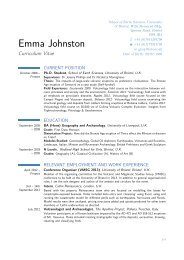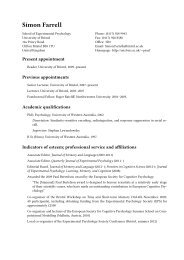What is Scientific Progress?
What is Scientific Progress?
What is Scientific Progress?
You also want an ePaper? Increase the reach of your titles
YUMPU automatically turns print PDFs into web optimized ePapers that Google loves.
proposition about the world. Such propositions can be used in explanations and predictions. For<br />
example, the fact it <strong>is</strong> approximately true that the only force acting on the Earth <strong>is</strong> a central force<br />
directed towards the Sun explains why the Earth’s orbit <strong>is</strong> approximately an ellipse. I think th<strong>is</strong> <strong>is</strong> a<br />
better explanation than one involving the ‘non-fact’ that (prec<strong>is</strong>ely) the only force acting on the<br />
Earth <strong>is</strong> a central force … . (Of course, explanations involving ‘approximately p’ are often parasitic<br />
on what p would explain if p were true. But perhaps not always. That the motion of a pendulum <strong>is</strong><br />
approximately simple harmonic <strong>is</strong> explained by the fact that for small θ, sin θ <strong>is</strong> approximately<br />
equal to θ. Th<strong>is</strong> <strong>is</strong> not best understood in terms of what would be explained if sin θ were exactly<br />
equal to θ. For if sin θ = θ (exactly) then θ=0, and we do not have any pendulum motion at all.)<br />
Having granted that concept of approximate truth has a use we can see that cases that show<br />
increasing nearness to the truth will also show the accumulation of (full) truth. And so those cases<br />
can in principle show the accumulation of knowledge also, should the required ep<strong>is</strong>temic conditions<br />
be met also. Such cases therefore present no special reason for preferring an account of progress in<br />
terms of ver<strong>is</strong>imilitude. Let be a series of hypotheses, accepted in that order over time,<br />
that monotonically get closer to the truth. Th<strong>is</strong> sequence shows progress according to the<br />
ver<strong>is</strong>imilitude account. We can see that there <strong>is</strong> also a d<strong>is</strong>tinct but related sequence of propositions,<br />
entailed by the first, that exhibits the accumulation of truth and (potentially) the accumulation of<br />
knowledge. Let A(. . .) be a propositional operator whose meaning <strong>is</strong> given thus: A(p) iff<br />
approximately p. 7 Assuming first, for simplicity, that all the pi are approximately true, the sequence<br />
of propositions will be a sequence of propositions each of which <strong>is</strong> fully true<br />
and adds to the truth provided by its predecessors. If these propositions are believed, then we have<br />
an accumulation of fully true propositions; and if they are sufficiently well supported by the<br />
evidence, the propositions will be known and we will have progress according the cumulative<br />
21






